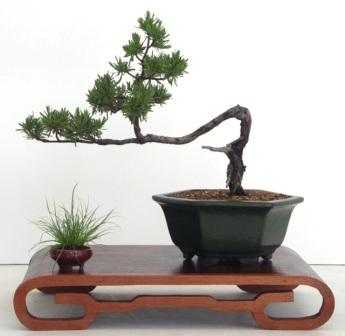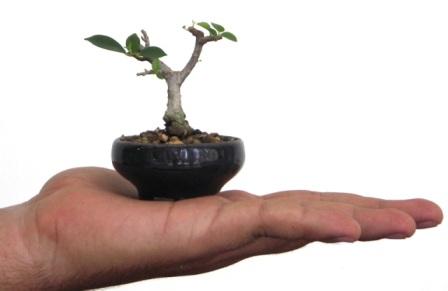Havana Bonsai Brighten Up Life
By LUCIA LOPEZ COLL

HAVANA TIMES, Jan. 9 (IPS) – Jorge Luis Guerra is convinced that his amazing recovery after the infarct he suffered some years ago has a great deal to do with his love for bonsais, which even without it began to change his life.
The word bonsai is used in the West as an umbrella term for all miniature trees in containers or pots, but properly should be applied only to container-grown trees following the Japanese tradition.
As president of the Havana Bonsai Group, (founded in 2002 after a course he taught) Guerra welcomed me in a small room of the capital’s Museum of Decorative Arts, where he constantly receives applications to enroll in the next course he will teach on bonsai techniques.
“We already closed the enrollment with 53 students, which is why we are thinking of opening another course with those people who were not to register,” said Guerra.
What do you attribute so much interest to?
One of the reasons could be the timing, because the media greatly backed us with the 2nd National Biennial last August. Foreign press agencies have also given excellent coverage to what we do. A second reason is historical-cultural, since it is a very pleasant and spiritual occupation that helps to meditate in the broadest and purest sense of the word. And although it requires knowledge, it is something easy that can accompany you throughout your life, and even several generations of your family, which is why it is very attractive and right now there’s an international boom of bonsai cultivation.
Today there is even talk of the “masters of the bonsai”, who are the 10 or 15 most important teachers in the world, almost all of whom are Japanese. There are also important collectors, and even at the Metropolitan Art Museum of Tokyo auctions are held with trees going for US $10,000, $20,000, $25,000, and we have references of trees sold for a quarter of a million dollars, although of course in Cuba such valuable specimens do not exist.
Where did the idea of creating Havana Bonsai come from?

A few years ago there were only a few of us who worked with bonsais in the country, perhaps some 15. We got to know each other, we exchanged information, and then one day we came to the conclusion that for bonsai cultivation in Cuba to prosper we had to add people, and we began to give courses to pass on what we knew.
In 1998 another colleague and I gave a first course at the Asia House and the Quinta de los Molinos. I remember that at the end of the third year we organized a sort of end of course party and another colleague — who today still forms part of the group and whom we jokingly call our great mother — said that should not be a farewell, and proposed that we organize ourselves in one way or another.
I was rather skeptical because other attempts had failed, but they convinced me in the end and that’s how, in a bit of an improvised way, I became the head of the project. We continued with the courses and we began having meetings to exchange books, information, and whatever each of us could contribute. At the end of each course I proposed to the more advanced and interested students to join the group.
Havana Bonsai does not have the status of an NGO and neither does there exist a Cuban bonsai association, although we would want one to be created, since up to now no institution has provided us with this type of support. For the time being, the National Heritage Council has provided us the Museum of Decorative Arts as our official headquarters and for three years all our activities have been carried out linked to the museum.
Here we get some material backing, although the group is responsible for the organization of all our events and each one has his/her responsibility. On even years we hold the National Biennial. The first was in 2006 and in August 2008 the 2nd Biennial took place. It is a competitive event for aficionados who can cover their on lodging and transportation.
Moreover, we have created another event for the uneven years, called “Art I am among the Arts”, and event focused on the artistic dimension of the bonsai.
For this occasion we organize an expo-sale where the group members participate, and a percentage of what is collected is given to the Museum. Both events are well attended and during the 2nd Biennial we counted 3,313 visitors in just four days.
We still don’t have the possibility of competing internationally, although the Heritage Council has promised us that in 2010 the 3rd Biennial will have an international character. Our web page (http://bonsaihabana.vndv.com) is going to be two years old. It has an average of 18 and 26 visits a day and many of those visits are from abroad. People are getting to know us and if we make an official announcement I believe several experts are going to come, as jury members and to make demonstrations.
At present the Havana Bonsai Group has 66 members and is very heterogeneous with very wide age spectrum. There are doctors, geologists, artists, accountants, engineers, cleaning people and even a 12-year-old boy. These are people who love nature and some of them, like me, are bonsai addicts.
What does it mean to be a bonsai addict?

I consider myself an addict, just like other group members, because I am a lover of this subject, which undoubtedly represents one of the most attractive and interesting things in the private life of each one of us. We invest a lot of time and money in this, since going to collect implies the cost of transport, in addition to the purchase of tools and certain materials, as occurs with the flowerpots. We have visited different individual ceramists and state workshops but we haven’t been able to obtain a steady supply of the very special receptacles.
Access to information is neither easy and search takes time. In terms of the care the plants require, you must water them every day and in some cases the best way of caring for them is to work on them a little every day. Therefore, I dedicate an average of an hour and a half each day on them or an entire day on weekends, depending on the time of the year, since the care is different in each season. The amount of trees also has an influence. I have some 50, just like other colleagues from the group, with trees in different stages.
After speaking so much about the bonsai, how would you define them?
The bonsai is a small tree that is artistically educated in a special flowerpot for this. It is considered an art because the design, the finishing of the tree, has implicit certain aesthetic, Asian and above all Japanese patterns.
There is a belief that many years are required to achieve a bonsai and that you just give a few clips and that’s enough. It’s exactly the opposite. After reading and studying a lot, with that knowledge you can achieve a bonsai in two years, just like a sculptor or a painter create their work.
There are norms for the design of bonsais that are very linked to Buddhism which originally had an influence on their development, such as the idea of the earth-man-divinity eternal triangle. However, learning the bonsai technique today and devoting oneself to their cultivation is, above all, a way of getting close to nature.

I want to cooperate with Cuban bonsai association and to get good relationship with Cuban bonsai club.
Please would you inform to me how I contact with Cuban Bonsai Association and some Cuban Bonsai Clubs!
I am a [email protected]
I am a Korean.
Quisiera infor. acerca de Bonzaista en Cuba